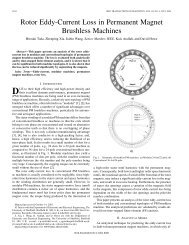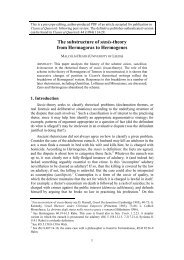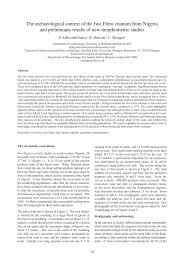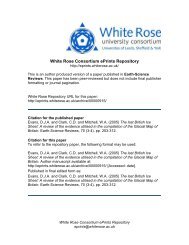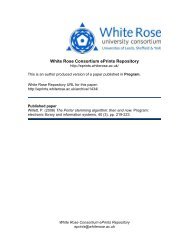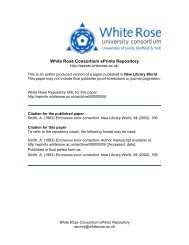The last British Ice Sheet: A review of the evidence utilised in the ...
The last British Ice Sheet: A review of the evidence utilised in the ...
The last British Ice Sheet: A review of the evidence utilised in the ...
You also want an ePaper? Increase the reach of your titles
YUMPU automatically turns print PDFs into web optimized ePapers that Google loves.
<strong>The</strong> maximum sou<strong>the</strong>rly extent <strong>of</strong> this Celtic Sea ice lobe has been mapped on <strong>the</strong> Scilly Isles us<strong>in</strong>g<br />
stratigraphic <strong>evidence</strong> for a Devensian glaciation (Scourse, 1986, 1987, 1991a,b; Scourse and Furze, 2001).<br />
Specifically, solifluction breccia overly<strong>in</strong>g and enclos<strong>in</strong>g organic layers has been observed to overlie a raised<br />
beach deposit. Radiocarbon dates and palynological <strong>evidence</strong> from <strong>the</strong> organics record a tundra grassland<br />
between 34 ka and 21 ka BP. <strong>The</strong> breccia is overla<strong>in</strong> by till (Scilly Till) <strong>in</strong> <strong>the</strong> nor<strong>the</strong>rn Scillies and by loess<br />
on <strong>the</strong> sou<strong>the</strong>rn isles, <strong>the</strong> loess hav<strong>in</strong>g been dated by <strong>the</strong>rmolum<strong>in</strong>escence at 18.6 ka BP (W<strong>in</strong>tle, 1981).<br />
Earlier work by Mitchell and Orme (1967) identified a sou<strong>the</strong>rn limit for <strong>the</strong> glacial deposits that imp<strong>in</strong>ged<br />
upon <strong>the</strong> north coasts <strong>of</strong> <strong>the</strong> nor<strong>the</strong>rn Scillies. <strong>The</strong>y proposed a Gipp<strong>in</strong>g (Wolstonian) age for <strong>the</strong> till based<br />
upon comparisons with stratigraphic sequences <strong>in</strong> southwest England. Bowen (1969, 1973b) later argued that<br />
<strong>the</strong> till had been soliflucted after hav<strong>in</strong>g been deposited orig<strong>in</strong>ally <strong>in</strong> <strong>the</strong> Wolstonian. <strong>The</strong>se age estimates<br />
were based upon “<strong>the</strong> <strong>in</strong>terpretation <strong>of</strong> <strong>the</strong> number and age <strong>of</strong> <strong>the</strong> stratigraphically juxtaposed raised beach<br />
units” (Scourse, 1991b) on <strong>the</strong> isles and <strong>the</strong>refore are less secure than <strong>the</strong> age derived from large numbers <strong>of</strong><br />
absolute dates on <strong>the</strong> sub-till breccia. Characteristics <strong>of</strong> <strong>the</strong> Scilly Till are summarized by Scourse (1991a,b;<br />
Hiemstra et al., <strong>in</strong> press). It conta<strong>in</strong>s abundant siliceous sponges and Miocene glauconite-bear<strong>in</strong>g micritic<br />
limestone derived from <strong>the</strong> Jones Formation ly<strong>in</strong>g <strong>of</strong>fshore to <strong>the</strong> north (Pant<strong>in</strong> and Evans, 1984), <strong>in</strong>dicat<strong>in</strong>g<br />
that it is derived from <strong>the</strong> sou<strong>the</strong>rn Celtic Sea. <strong>The</strong> cont<strong>in</strong>uation <strong>of</strong> <strong>the</strong> till <strong>of</strong>fshore has been assessed by<br />
Scourse (1986) and Scourse et al. (1990, 1991, 2000) based upon samples collected and analysed previously<br />
by Pant<strong>in</strong> and Evans (1984). <strong>The</strong> characteristics <strong>of</strong> “till-like” materials <strong>in</strong> <strong>the</strong> Devensian Melville Formation<br />
(Cameron and Holmes, 1999) ly<strong>in</strong>g <strong>in</strong> <strong>the</strong> sou<strong>the</strong>rn Celtic Sea have been <strong>in</strong>terpreted as <strong>the</strong> deposits <strong>of</strong> an ice<br />
stream emanat<strong>in</strong>g from <strong>the</strong> Celtic Deep to <strong>the</strong> south <strong>of</strong> St George’s Channel and flow<strong>in</strong>g southwestwards<br />
towards <strong>the</strong> shelf edge. A change <strong>in</strong> depositional processes at approximately 49°30΄ is thought to represent<br />
ei<strong>the</strong>r a ground<strong>in</strong>g l<strong>in</strong>e position or a change from proximal to distal glacimar<strong>in</strong>e deposition (Scourse, 1986;<br />
Scourse et al., 1991). <strong>The</strong> “till-like” material <strong>in</strong> <strong>the</strong> Melville Formation is correlated with <strong>the</strong> Scilly Till by<br />
Scourse et al. (1991), imply<strong>in</strong>g that <strong>the</strong> Diml<strong>in</strong>gton Stadial ice <strong>in</strong> <strong>the</strong> Celtic Sea was considerably more<br />
extensive than <strong>the</strong> previously accepted limits. This more extensive coverage has ga<strong>in</strong>ed support from more<br />
recent work <strong>in</strong> sou<strong>the</strong>rn Ireland (see below). In <strong>the</strong> Irish Sea, St George’s Channel and north Celtic Sea<br />
conta<strong>in</strong> two widespread deposits l<strong>in</strong>ked to <strong>the</strong> whole Devensian Stage but also document<strong>in</strong>g Diml<strong>in</strong>gton<br />
Stadial glaciation (Cameron and Holmes, 1999). <strong>The</strong> Western Irish Sea Formation and Cardigan Bay<br />
Formation <strong>in</strong>clude glacigenic sediments relat<strong>in</strong>g to <strong>the</strong> <strong>last</strong> glaciation. Specifically, <strong>the</strong> Upper Till Member <strong>of</strong><br />
<strong>the</strong> Cardigan Bay Formation is <strong>in</strong>terpreted as a basal till and correlated with <strong>the</strong> Irish Sea Drifts <strong>of</strong> sou<strong>the</strong>rn<br />
Ireland by W<strong>in</strong>gfield (1994, 1995). <strong>The</strong> Western Irish Sea Formation <strong>in</strong>cludes waterla<strong>in</strong> sediments and is<br />
sub-divided <strong>in</strong>to Formation B, <strong>the</strong> uppermost <strong>of</strong> which is coeval with <strong>the</strong> Upper Till Member <strong>of</strong> <strong>the</strong> Cardigan<br />
Bay Formation, and Formation A, predom<strong>in</strong>antly deglacial glacimar<strong>in</strong>e sediments and <strong>the</strong> <strong>in</strong>fills <strong>of</strong> deep<br />
glacial <strong>in</strong>cisions (W<strong>in</strong>gfield, 1994, 1995). <strong>The</strong> very patchy nature <strong>of</strong> <strong>the</strong> Upper Till Member <strong>in</strong> <strong>the</strong> Celtic Sea<br />
51




